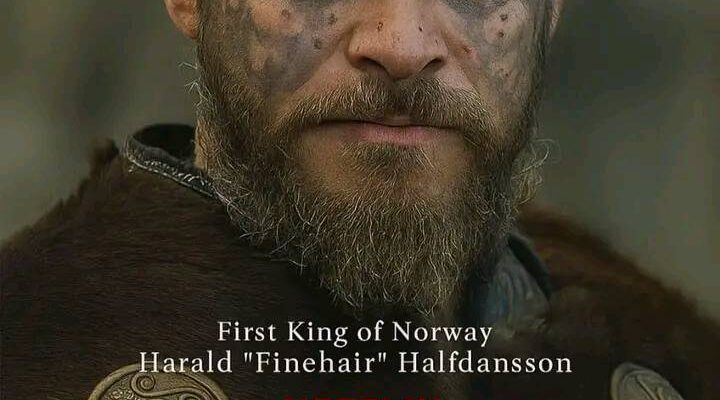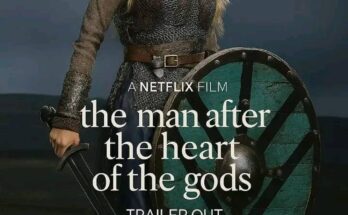Freshly unveiled: The legendary saga of Harald “Fairhair” Halfdansson, the first king.
Freshly unveiled to audiences both young and old is the legendary saga of Harald “Fairhair” Halfdansson, remembered in Norse tradition as the first king of a unified Norway. This tale, preserved through centuries of oral storytelling and later recorded in sagas and chronicles, remains one of the most enduring epics of leadership, ambition, and destiny from the Viking Age. The story of Harald Finehair does not merely recount the rise of a single man to kingship but reflects the cultural spirit, values, and turbulent world of Scandinavia during the ninth century. It is a chronicle that weaves together history and myth, giving us insight into the formative struggles that shaped the Nordic kingdoms and left a lasting imprint on European history.
Harald’s saga begins in an age when Norway was not a unified land but a patchwork of petty kingdoms, each ruled by chieftains and local lords. These rulers often feuded over territory, wealth, and honor, with alliances forming and breaking in cycles of blood and steel. Born as the son of Halfdan the Black, a notable king of the Vestfold region, Harald inherited not only a claim to noble blood but also a vision that went far beyond the borders of his father’s domain. His birth was said to be marked by omens, a common motif in Norse storytelling, and his early life already hinted at the strength and determination that would carry him into the annals of legend.
According to tradition, Harald’s most famous vow was inspired not by politics alone but by love. He was said to have fallen deeply for a woman named Gyda, the daughter of a powerful chieftain. When Harald sought her hand, Gyda is said to have refused his proposal, declaring that she would only marry a man who ruled all of Norway. Instead of taking offense, Harald accepted this challenge with fiery resolve. He swore that he would not cut or comb his hair until he had conquered and united the entire land beneath his rule. It was this vow that earned him the epithet “Fairhair,” for once his quest was complete and he finally cut and groomed his hair, it was said to shine with unmatched beauty.
The path to kingship was neither simple nor swift. Harald faced years of conflict as he fought rival rulers who resisted the idea of unification. Battles raged across fjords and valleys, with shifting alliances and fierce opposition from those who valued independence above submission. Yet Harald proved himself a cunning strategist and an unyielding warrior. He built alliances when they suited him and crushed opposition when necessary, gradually extending his dominion. Some chieftains submitted willingly, seeing greater security under a strong king, while others fought bitterly until they were forced to yield. The saga presents Harald as a man driven by destiny, whose determination never faltered even in the face of overwhelming odds.
One of the decisive moments in Harald’s rise was the Battle of Hafrsfjord, a legendary clash remembered as the turning point in Norway’s unification. Here, Harald’s forces confronted a powerful coalition of rival kings and chieftains who sought to halt his growing dominance. The battle was fierce and bloody, with ships colliding, swords flashing, and arrows raining down. Yet Harald’s leadership prevailed, and his victory at Hafrsfjord secured his place as the undisputed ruler of Norway. From this moment on, the fragmented kingdoms were bound together under one crown, marking the birth of the Norwegian monarchy.
Harald’s reign as the first king was not without challenges. While he had succeeded in uniting the land, maintaining control over such a vast and diverse territory required constant vigilance. Local leaders who had once ruled independently often bristled under royal authority, and rebellions flared up in various regions. Harald established new systems of governance, placing loyal jarls to oversee different territories, but the tension between local autonomy and central authority remained a defining struggle of his rule. Despite this, Harald’s legacy was cemented by the sheer audacity of his achievement: transforming a land of warring chieftains into a unified kingdom.
The saga of Harald Fairhair is also deeply interwoven with themes of destiny and the divine. Norse mythology often portrays rulers as chosen or favored by the gods, and Harald was no exception. His strength and charisma were seen as gifts from Odin, the all-father, and his victories were interpreted as signs of divine favor. This blending of myth and history gives the tale its legendary quality, reminding us that in the Viking Age, history was not simply recorded as fact but as a living narrative shaped by the values and beliefs of the people.
Harald’s story did not end with his conquests. He lived long enough to see the consequences of his rule, including the struggles among his many sons. Like many Viking rulers, Harald had numerous wives and concubines, leading to a brood of ambitious heirs, each eager to claim their portion of power. These internal disputes would shape the generations that followed, as succession conflicts and rivalries splintered the unity Harald had fought so hard to establish. Yet even amid these challenges, his figure remained towering, a symbol of what was possible when determination and vision overcame division.
Over the centuries, Harald Finehair’s saga has been retold in countless forms, from medieval chronicles like Snorri Sturluson’s Heimskringla to modern retellings in literature and television. Each version adapts the tale to its audience, sometimes emphasizing romance, sometimes war, and sometimes the political genius of a man who rose above his time. His image as the first king of Norway endures not only as a historical figure but as a cultural archetype, embodying the ideals of courage, ambition, and unity.
The unveiling of this legendary tale in the present day offers more than entertainment; it connects us with the roots of Northern European identity. It recalls an age when the lines between myth and reality blurred, and when the deeds of extraordinary individuals shaped the destiny of nations. In Harald’s saga, we find echoes of universal themes: the pursuit of love, the struggle for power, the sacrifices required by ambition, and the enduring human desire to leave a legacy.
For modern audiences, the legend of Harald Fairhair resonates as both history and inspiration. It invites us to reflect on how determination can overcome obstacles, how vision can transform chaos into order, and how the actions of a single individual can ripple across centuries. While historians continue to debate the exact details of his life, the essence of his saga remains timeless, reminding us that legends often carry truths beyond mere fact.
The tale of Harald “Fairhair” Halfdansson, freshly unveiled once again, is not simply the account of a man who became king. It is the story of a people who found unity through conflict, of a land that was forged into a kingdom by the strength of will, and of a legacy that continues to shape identity more than a thousand years later. It is both legend and history, both inspiration and caution, and its telling ensures that the name of Harald Finehair will endure as long as stories are told.



